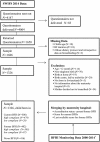Baby-Friendly Hospital designation has a sustained impact on continued breastfeeding
- PMID: 28795789
- PMCID: PMC6866148
- DOI: 10.1111/mcn.12497
Baby-Friendly Hospital designation has a sustained impact on continued breastfeeding
Abstract
The Baby-Friendly Hospital (BFH) Initiative has led to an increase in breastfeeding rates and duration worldwide. But little is known about whether the beneficial effects persist beyond a facility's designation as a BFH. To investigate the association of BFH designation (current, former, and never) and compliance with Baby-Friendly (BF) practices on breastfeeding in Switzerland, this study combined nationwide survey data on breastfeeding with BFH monitoring data. In this cross-sectional study, 1,326 children were born in 34 current (N = 508), 28 former (N = 425), and 34 never designated BFHs (N = 393). We compared exclusive and any breastfeeding according to BFH designation over the first year of life, using Kaplan-Meyer Survival curves. Logistic regression models were applied to analyse breastfeeding prevalence, and Cox-regression models were used for exclusive (0-6 months) and continued (6-12 months) breastfeeding duration. Average duration of exclusive breastfeeding (13.1 weeks, 95% confidence interval [12.0, 17.4]) and any breastfeeding (32.7 weeks, 95% confidence interval [30.5, 39.2]) were the longest for babies born in currently accredited BFHs. Exclusive breastfeeding was associated with high compliance with monitored BF practices in current BFHs and with the number of BF practices experienced in all hospitals. Continued breastfeeding was significantly longer when babies were born in current BFHs (cessation hazard ratio 0.60, 95% confidence interval [0.42, 0.84]) or in former BFHs (cessation hazard ratio 0.68, 95% confidence interval [0.48, 0.97]). Overall, the results support continued investment into BFHs, because babies born in current BFHs are breastfed the most and the longest, whereas a former BFH designation shows a sustained effect on continued breastfeeding.
Keywords: Baby-Friendly Hospital; Ten Steps; breastfeeding; continued breastfeeding; exclusive breastfeeding; sustainability.
© 2017 The Authors. Maternal and Child Nutrition published by John Wiley & Sons, Ltd.
Conflict of interest statement
The authors declare that they have no conflicts of interest.
Figures
References
-
- Baghurst, P. , Pincombe, J. , Peat, B. , Henderson, A. , Reddin, E. , & Antoniou, G. (2007). Breast feeding self‐efficacy and other determinants of the duration of breast feeding in a cohort of first‐time mothers in Adelaide, Australia. Midwifery, 23(4), 382–391. 10.1016/j.midw.2006.05.004 - DOI - PubMed
-
- Chien, L. Y. , Tai, C. J. , Chu, K. H. , Ko, Y. L. , & Chiu, Y. C. (2007). The number of baby friendly hospital practices experienced by mothers is positively associated with breastfeeding: A questionnaire survey. International Journal of Nursing Studies, 44(7), 1138–1146. 10.1016/j.ijnurstu.2006.05.015 - DOI - PubMed
-
- Conzelmann‐Auer, C. (2009). Neupositionierung des BFHI‐Labels in der Schweiz: Studie im Auftrag von unicef Schweiz. Retrieved from Zurich: UNICEF Switzerland.
Publication types
MeSH terms
LinkOut - more resources
Full Text Sources
Other Literature Sources
Medical
Miscellaneous



